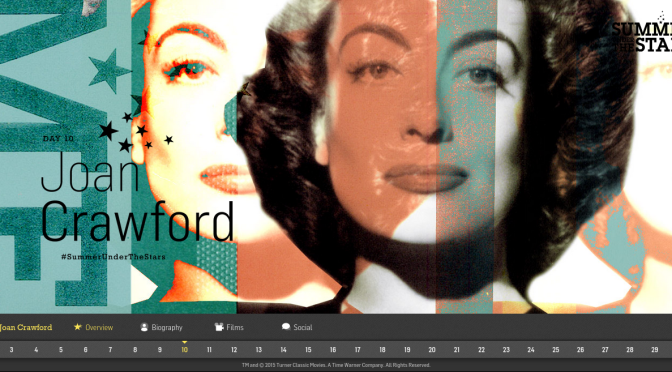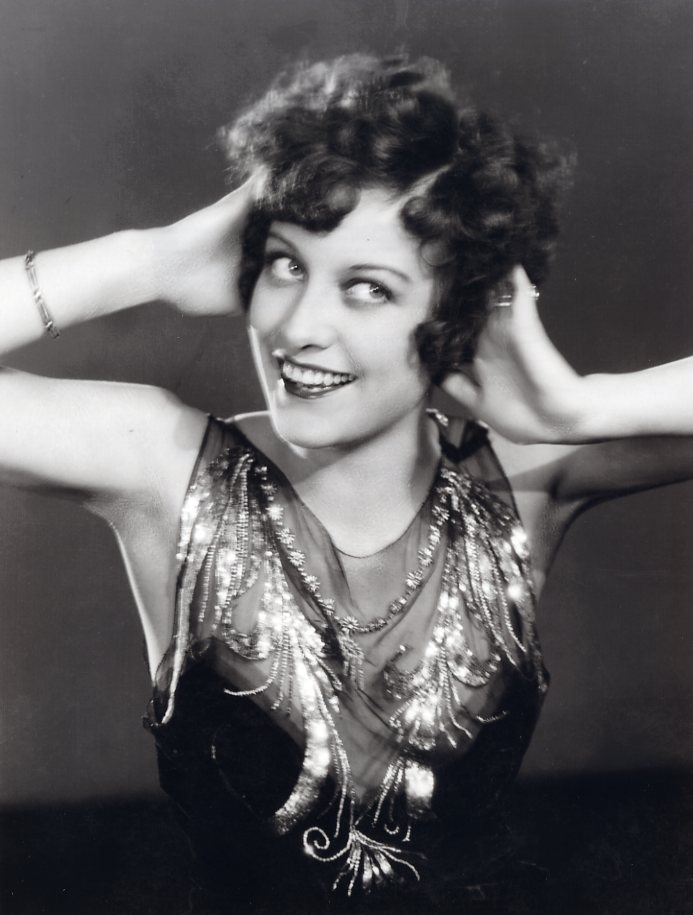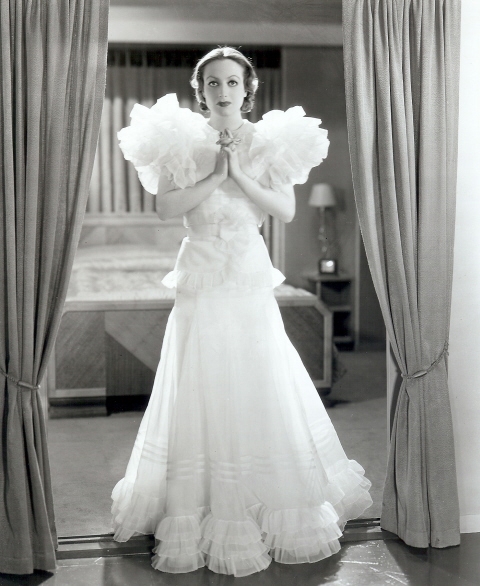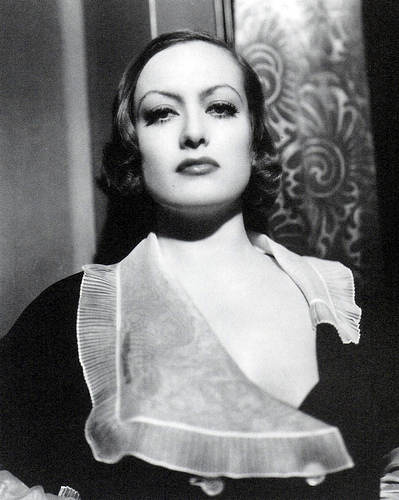This post is prt of the Summer Under the Stars Post Blogathon hosted by Journeys in Classic films
Joan Crawford started almost at the birth of MGM, in the silent, show-girl and flapper days of 1925. She even started before she was Joan Crawford. Her film career began under the name of Lucille Le Sueur, but when Louis B. Mayer noticed the vivacious and pretty Charleston dancer, he thought the name Le Sueur sounded too much like sewer, and so had it changed to Joan Crawford.
Joan had her first starring role in Sally, Irene and Mary in 1925, playing fast-living chorus girl Irene along with Sally (Constance Bennett) and Mary (Sally O’Neill). They each have their personalities, loves, and adventures, but it’s Irene that has the tragic end. Her next starring role was as the circus gypsy girl Nanon in The Unknown in 1927. Due to Lon Chaney’s acting it is as intense a silent film as you’re ever likely to see. Joan said she learned how to act from working with Lon Chaney in this film.
And then came Our Dancing Daughters in 1928, Joan’s first big starring role and the movie that made her a hit with young women across the country. Adrian had just been made Head Costume Designer at MGM, having come to the studio with producer Cecil B. DeMille that year. Adrian designed her costumes for the sequel film, Our Modern Maidens, and her next 28 films at MGM, creating her look on screen and off. About Adrian Joan Crawford later said, “Dear Adrian, he was the greatest costume designer of them all. There will never be a greater one.”
Joan realized early the importance of the star-making machinery, of which costume design was a foundation. Adrian’s talents extended beyond his fashion art, but embedded in his work was his understanding of the needs of the role, and significantly, the psychology of the actress and what it would take her to create that extra spark of creativity on the screen. In Joan’s flapper days, such as in Our Dancing Daughters (designed by David Cox) and in Our Modern Maidens, shown below, Joan embodied the notion of the flapper and was dressed perfectly as one. Later, when she played the sophisticated “kept woman” in Mannequin, Adrian dressed her in a completely different style for that role. And Joan absorbed these lessons in style and stardom eagerly. She wanted to pattern her stardom after Gloria Swanson, the greatest star from years before. Gloria Swanson was a fashion icon, always well dressed – always the star – a role played on and off the lot.
Adrian found Joan Crawford fascinating. Like the MGM star he loved most to dress, Greta Garbo, Joan presented him with the androgynous beauty that sparked his creativity. She had a beautiful figure with broad shoulders that Adrian admired, a “regular Johnny Weismuller” he reportedly said. She had normal hips, not wide as has often been reported, so there was no need to widen her shoulders in order to balance them out. Greta Garbo had wide shoulders too and Adrian used wide-shoulder costumes for both of them from 1929 on, just because he liked a wide-shouldered look on these two powerful women. Indeed, Adrian was always fascinated by polarities, and the contrast between the beautiful yet strong, almost dominant face of Joan Crawford below illustrates that characteristic.
The costume designed for Joan Crawford that made Adrian famous was the “Letty Lynton” dress, named for the 1932 film of the same title. It has not been seen in decades due to a copyright dispute, but the puffed-sleeve (or shoulders) white organdy dress was worn by Joan on a ship’s deck when Robert Montgomery compares her to an angel and asks her to marry him. The dress was knocked-off by American designers and sold at every price-point. Parisian designed copied it too, as did other costume dessigners. Edith Head stated it was the single most important fashion influence in film history. The Cinema Shop at Macy has often been cited as selling 50,000, or even 500,000 copies of the dress, although both figures are gross exaggerations done for marketing reasons. Versions of the dress can still be seen as wedding gowns.
The photo below is another gown from Letty Lynton, although it was shot on the set of Grand Hotel. The gown is made of white crepe and black bugle beads, with one section forming a wrap tied at her hips. The other, forming a true assymetry on her left side. The image itself is a master-work of Hollywood set photography, with Joan forming a crucifix at the swinging art-deco doors of the Grand Hotel.
In Grand Hotel, 1932, Joan played a secretary. Adrian dressed her simply in black dresses. Her predominant costume was the one shown below. Its large white collar emphasized her face, and its open structure showed her vulnerability to the advances of Preysing.
Greta Garbo also starred in Grand Hotel, although they did not share a scene. Garbo was notoriously reclusive and Joan had never talked with her on the MGM lot, and was rather intimidated by her. One day during the filming of Grand Hotel, Joan ran into Garbo on the stairs of the old MGM dressing rooms. Joan, locked in place and spellbound by Garbo, just said hello. Garbo put her hand to Joan’s face and said, “What a pity, our first picture together and we don’t work together. I am so sorry. You have a marvelous face.” Years later in retelling this story Joan said, “If there was ever a time in my life when I might have become a lesbian, that was it.”
Adrian used the symbolic power of the modified trench-coat on Joan Crawford, just as he had with Greta Garbo since 1928. Below Joan is shown in Possessed, 1931. The Coat is only slightly feminized with the bow at the collar and at the belt, which is neutralized by a floppy cloche hat serving as a sort of fedora. She wears this outfit as she stands up to hecklers admitting that she’s the mistress of Clark Gable/ the character Mark Whitney, running for governor, but that he is an honorable man that once belonged to her but that now belongs to the people.
Joan Crawford, like many young actresses at MGM, had gone through voice class to lose her native twang and regional accent. While Joan had developed a beautiful speaking voice, there was no mistaking that she was a working class girl, and always seemed natural in the many rags to riches roles she played. It was also a factor in her popularity with the many young women moving into the cities and who were entering the workforce in the late 1920s and 30s.
TCM’s Summer Under the Stars is also playing Sadie McKee, a story where Joan starts out as a household maid, then becomes a dancer, and finally the wife of a rich man, though not the man she loves, played in the film by Gene Raymond. This was another film where Joan co- starred with a future husband, in this case Franchot Tone. She had previously co-starred with Douglas Fairbanks Jr. in Our Modern Maidens (1929), whom she first married. And then of course there was Clark Gable, with whom she co-starred in eight films. They never married, although they carried on an affair that lasted many years. They always seemed well paired in their roles together, and their chemistry was always hot.

Sadie Mckee features a rare Adrian-designed gown that bares Joan’s shoulders. The sequined halter adds a lot of dazzle to the long black gown.

Probably the film where costume plays its most important role ever is The Bride Wore Red (1937), directed by Dorothy Arzner and starring Joan Crawford with Franchot Tone and Robert Young. Simply, an aristocrat character bets that he can take a tavern singer played by Joan and through a good wardrobe can pass her off as a high-society heiress at an exclusive mountain resort. His theory is that only luck separates the characteristics of the rich from the poor, so change the appearance and you change the person. and there ensnare the affections of the Robert Young character who disbelieves this theory. So he gives “Anni” enough money to buy an expensive wardrobe, and she chooses the most eye-popping brilliant-red bugle-beaded gown with matching cape in the store. So in this fractured-Cinderella-fairy-tale she goes off on the train to the Alps, where the postman played by Franchot Tone picks her up in a donkey-cart, her taxi to the resort. The costumes continue to play their significant part in this movie, not to make the actress feel comfortable in her role, but in this Dorothy Arzner film, to always feel like she has chosen the wrong wardrobe for the occasion.
It’s a bit of an irony that The Bride Wore Red was a black and white film, so who would have known what color the bride was wearing, even though she was not to be the princess bride. The photo below shows the gown as it looks today, miraculously preserved and in the collection of the Museum of the Fashion Institute of Technology, although here shown at the Hollywood Costume exhibition at the V&A Museum in London.
The roles Joan played after World War II satisfied her less and less. Change was taking place at MGM. Garbo had left, and after that Adrian. Even her long-time rival Norma Shearer has retired. New stars were getting the choice roles: Katharine Hepburn; Greer Garson; Hedy Lamar; and Lana Turner. After a long review of her options, Joan had a meeting with Louis B. Mayer and asked to buy out the rest of the time on her contract. So on June 29, 1943, Joan left MGM, her home for eighteen years. Her last task was to clean up her dressing room, not just to pack up her personal belongings, but to physically clean it as well. No farewell party was held to see her off.
Her agent Lew Wasserman got her a contract at Warner Brothers., where a new phase of her career began. She was once again given more serious roles in this new age of film noir. There was Mildred Pierce in 1945 for which she won a Best Actress Oscar. With new clout, she returned to Adrian for her wardrobe, selecting costumes from among his designs at his new fashion salon in Beverly Hills. Thus did her next two films, Humoresque, and Possessed, get costumed by Adrian. Joan is magnificently dressed in Humoresque, showing a mature beauty in an elegant and classic wardrobe. Possessed calls for a simple wardrobe. In the film Adrian used a technique of reversing a white collar on a black dress, having the points of the collar turned to the back of the dress. The look has been copied many times since.
Joan Crawford went on to a long career, embodying what it was like to be a star in Hollywood’s Golden Age, and beyond. Adrian’s star burned bright while it lasted, but his health failed him. A heart attack forced him to give up his own influential fashion line in 1952, and a planned comeback was stopped by a terminal stroke in 1959. Fortunately we have those many films to see for ourselves on TCM and elsewhere the art that was created in this collaboration and under the talented umbrella of many at in the Hollywood dream factories.
Views: 372










Ah this look, pose and glamour from Sadie McKee…no one screamed Movie Star like Joan. The absolute top of the Golden age heap.
Excellent piece about Crawford and her fashion dynamics, Christian. Of all those fabulous dresses, I have to say that the picture of her in the ultra-feminine yet tough-looking trench coat and hat really took my eye!
Thanks for the comment Becky. That is a great outfit and a stunning photo – one of my favorites too.
Joan Crawford has always seemed to me the ultimate movie star. That was the great role of her life and she seemed born to play the part. Adrian’s gowns certainly had a lot to do with establishing her as a great and glamorous star. I’ve always loved the Letty Lynton dress (though I could never have worn it myself).
Lady Eve, yes she was the ultimate movie star, a role she was fanatic about. But this also extended to caring about all the trade craft people at the studio she worked with and helped her in achieving and maintaining that stardom. And of course that same exactitude extended to her wardrobe, and she knew that Adrian gave her a variety of stylish looks that helped make her star persona. It’s hard to fathom too that she was a short woman, just over 5ft.- she seems to tower in that Petty Lynton dress, and in others.
She has always seemed statuesque to me, anything but tiny. Credit to Adrian for aiding with that illusion, too. If I’m not mistaken, Norma Shearer was also not much more than 5′, but she didn’t appear taller. Maybe that was because didn’t have the grandeur Crawford projected or, perhaps, it was her figure.
Good point Lady Eve about Norma Shearer, she had a different figure challenge for Adrian to design for, so making her short legs seem normal didn’t allow for the illusion of height. Yet he still gave her much sex appeal.
Adrian and Crawford are a grand slam home run. I prefer his designs for her over those he did for Garbo. My favorite is the gown she wore in “Forsaking All Others” – just drop dead movie star gorgeous!
Yes FlickChick, he turned on the high-amp movie-star look in many of Joan’s gowns. If you are thinking of the satin gown with the slings at the bodice in Forsaking All Others, that would certainly be one. He once said that Joan was the one star that could really carry-off exaggerated looks (although he didn’t dress Marlene Dietrich). But then he designed really simple and elegant dresses for her too and they worked as well. It all depended on the role and the movie.